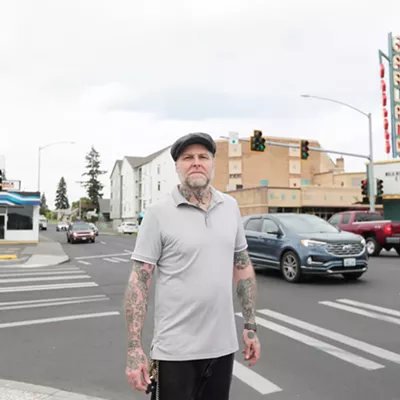Outside the MAC, melting snow leaves traces over rocks. Tree branches cut across the sky, and everyone makes footprints where mud has gathered.
Inside the MAC, pieces of lumber are scarred by chainsaws. Painted shapes and lines cover flat expanses of wood and paper, and strips of wire channel themselves across a stump.
"My work leaves tracks and marks," Richard Schindler says, looking at his sculptures and paintings. The second show in the Northwest Museum of Arts and Culture's "In Focus" series of local artists, Schindler's pieces fill the entrance lobby of the museum. The massive, man-sized pieces of lumber and constructions of metal stand in a row. Deep gauges are cut in the wood, and the metal is, frequently, rusting. Along the right wall, where a display case used to stand, hang Schindler's paintings, many of them the size of plywood sheets. Some of them are so coated with paint that their surfaces look half carved.
Seen here, in the MAC's most beautiful room, Schindler's works immediately fall into place. Like the slowly changing world visible outside the museum's large windows, Schindler's pieces are the results of slow modifications and gradual interference. And while they don't exactly look like the trees, stones, and landscapes that they all began as, they reveal themselves to the viewer with an artistic honesty. His paintings present their lines and shapes on backgrounds as depthless as snowy fields and cloud-flecked skies. The ripples in the grain of a piece of cedar that Schindler has peeled for a sculpture not only recall the tree, but suggest wind moving across a prairie or waves mottling a river.
"Each material has its own vocabulary," Schindler explains. "That's what I try to discover."
Schindler's work, which is most easily described as "natural collage," takes place gradually. He explains his working process, which with the accumulation of hundreds of pieces of metal and wood, as "collecting."
"I live with these things for a while," he says, laughingly describing yards and buildings littered with the bones of trees and machines. "There is something about the different forms -- a kind of recognition that will capture my attention initially. Sometimes I know what it is right away. But usually I live with it until I get the urge to make a mark or a cut."
Far from seeming intrusive, Schindler's marks on his sculptures and paintings look natural. The small squiggles hollowed out of the wood by worms are echoed by channels Schindler has routed himself. And large, dramatic cuts look as if they might have been made when a tree snapped in a storm. Even the paintings, many of them on wooden surfaces, are cut around the images painted on them; the materials accommodate Schindler's lines and cuts as though they had grown together.
Despite the sculptures' bulk and the paintings' density, Schindler's pieces feel spontaneous and natural. "It all follows the first gesture -- the urge to shape the form, Schindler explains. "What follows that is the discovery of what's in the wood. It can take a long time. And I try not to rush anything. There is something really important in the process for interruptions. I had started painting this," he gestures toward three massive beams that have been cut and stacked, "and then I stopped, and came back to it, and really liked it the way I had left it."
Both the paintings and the sculptures survive as records. The bulky materials call to mind the overwhelming scope of the world we often forget when we step through the museum doors. Each cut, line, and connection made by Schindler echoes a thought process, or a creative impulse that he once had.
"I love the remnants of buildings," he continues, looking at one of his sculptures almost as though he were seeing it for the first time, studying the wood itself. "I love the effect nature has on different materials. What remains is what is really interesting to me."
If Schindler's work is informed by the ebb and flow of the natural world, the In Focus series similarly evokes a sense of flux. The series will only be up at the MAC through July, and the artists change each month.
"This series gives us a chance to do focused, one-person exhibitions for artists who -- for a variety of reasons -- might be under-recognized in this community," says Jochen Wierich, curator of the MAC. "At the same time, these are artists who have a strong record, who have had exhibitions before of museum-quality work."
"In Focus" is also culled from the considerable collection of the MAC's Art at Work Gallery; some artists are already familiar to local audiences, while others will be new discoveries. After the Schindler exhibit comes down at the end of the month, the minimalist abstracts of Megan Murphy go up for March, followed by Keiko Hara, Wendy Franklund Miller, Lanny De Vuono and a WAMPUM-related group show. With so much periodic change going on at the MAC lobby, the effect is one of ever-changing moods and themes -- not unlike, perhaps, knowing one's city by heart, yet finding it utterly different from day to day as the seasons progress.
Publication date: 02/05/04














